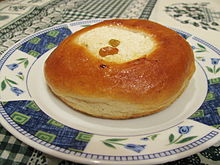 Vatrushka with golden raisins | |
| Type | Pastry/ pirog |
|---|---|
| Place of origin | Eastern Europe |
| Main ingredients | Dough, Tvorog |
| Variations | with raisins or dried fruits |
Vatrushka ( Russian: ватрушка) is an Eastern European pastry ( pirog) formed as a ring of dough with traditional white cheese Tvorog in the middle, sometimes with the addition of raisins or bits of fruit. [1] The most common size is about 5–10 cm (2–4 in) in diameter, but larger versions also exist. Vatrushkas are typically baked using a sweet yeast bread dough. Savoury varieties are made using unsweetened dough, with onion added to the filling. [2] [3] [4]
The etymology of the word is uncertain. A widespread hypothesis derives the name from the word vatra meaning "fire" in some Slavic languages (Ukrainian for example). According to another version, the word is borrowed from the Romanian language, in which "vatra" meant "a kind of cake, cooked in the fire". [5] Alternative hypotheses trace it back either to the verb teret (тереть, "to rub" or "to grate") or to the term tvorog (творог). [6] [7] [8]
See also
References
- ^ "Vatrushka | Traditional Sweet Pastry From Russia | TasteAtlas". www.tasteatlas.com. Retrieved 2023-03-23.
- ^ Ekaterina & Lludmila Bylinka (2011). Home Cooking From Russia: A Collection of Traditional, Yet Contemporary Recipes. Bloomington, Indiana: AuthorHouse. p. 94. ISBN 9781467041362. Retrieved 30 November 2012.
- ^ Tatiana Smorodinskaya; Karen Evans-Romaine; Helena Goscilo, eds. (2013). Encyclopedia of Contemporary Russian Culture. Routledge. p. 136. ISBN 9781136787850.
- ^ William Pokhlyobkin (1988). O kulinarii ot A do Ya: Slovar-spravochnik (О кулинарии от А до Я: Словарь-справочник) [Cookery from A to Z] (in Russian). Minsk: Polymia. p. 38. ISBN 5-345-00218-5. Archived from the original on 2014-02-02. Retrieved 2016-11-19.
- ^ Brovkina, Olga (August 26, 2021). ""Korolevskaja Vatrushka", il dolcetto russo che ha origini popolari ma un nome da re". Russia Beyond IT (in Italian). Retrieved 2023-03-23.
- ^ Vasmer, Maksimilian Romanovich (1973) [1958]. Etimologichesky slovar russkogo yazyka (Этимологический словарь русского языка) [Etymological Dictionary of Russian Language] (in Russian). Moscow: Progress.
- ^ Shanskiy, N. M.; Bobrova, T. A. (2004). Shkolny etimologichesky slovar russkogo yazyka. Proiskhozhdenie slov (Школьный этимологический словарь русского языка. Происхождение слов) [Etymological School Dictionary of Russian Language] (in Russian). Moscow: Drofa.
- ^ Krylov, P. A. (2005). Etimologichesky slovar russkogo yazyka (Этимологический словарь русского языка) [Etymological Dictionary of Russian Language] (in Russian). St. Petersburg: Victoria Plus. Archived from the original on 2019-02-12. Retrieved 2016-11-19.